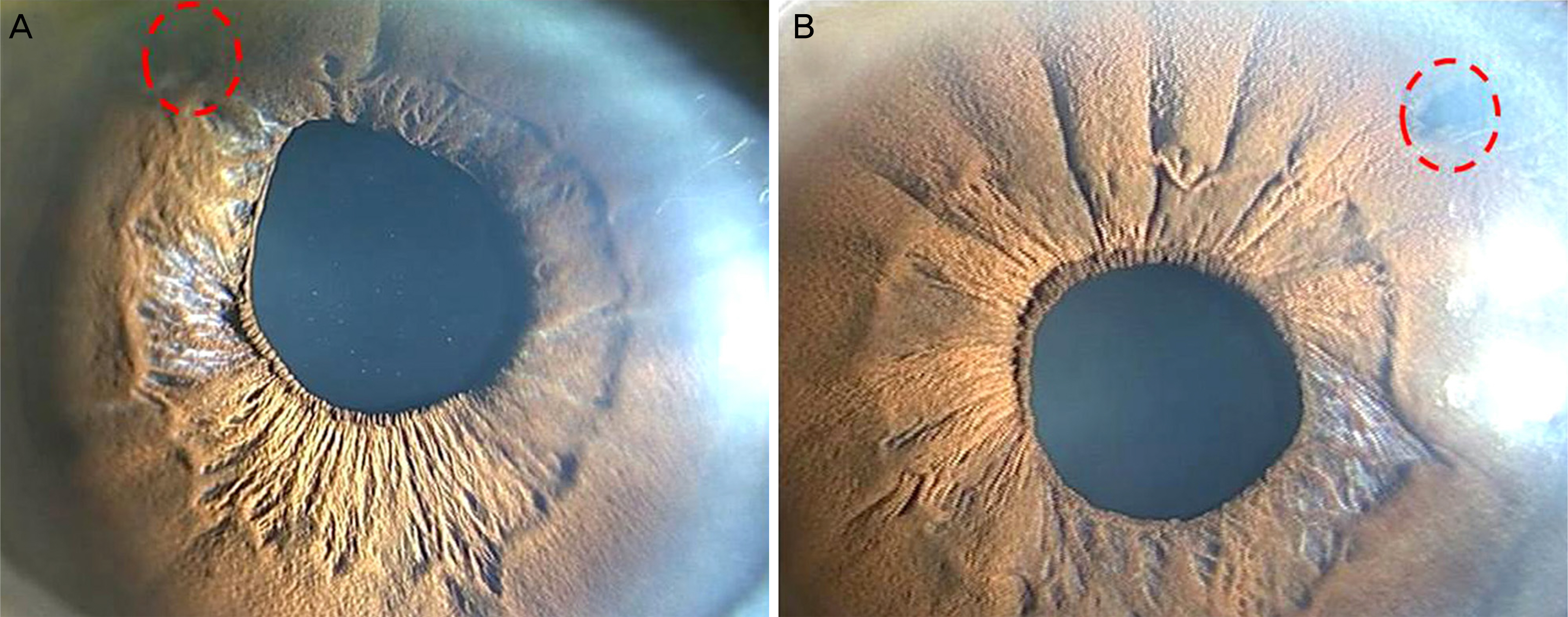J Korean Ophthalmol Soc.
2016 Feb;57(2):334-340. 10.3341/jkos.2016.57.2.334.
A Case of Bilateral Acute Angle Closure Attack Induced by Common Cold Medication
- Affiliations
-
- 1Department of Ophthalmology, Hanyang University College of Medicine, Seoul, Korea. francis33@naver.com
- KMID: 2213678
- DOI: http://doi.org/10.3341/jkos.2016.57.2.334
Abstract
- PURPOSE
The authors report a case of bilateral simultaneous acute angle closure attack following administration of an over-the-counter common cold medication (ingredients: chlorpheniramine maleate, phenylephrine hydrochloride, and belladonna alkaloid).
CASE SUMMARY
A 67-year-old man visited the emergency room with a sudden onset of bilateral blurred vision and ocular pain accompanied by headache, nausea, and vomiting. He had taken an over-the-counter common cold medication three times per day for three days before the visit. His visual acuity was 0.3 and 0.7 and intraocular pressure (IOP) was 50 mm Hg and 40 mm Hg in right and left eye, respectively. The refraction in manifest refractive test was +0.75 D sph = -0.75 D cyl x 100 in right eye and +1.25 D sph = -1.25 D cyl x 80 in left eye. The anterior chamber depth was three times the corneal thickness in center and less than 1/4 of the corneal thickness in periphery in both eyes on van Herick method. The angles of both eyes were closed on gonioscopy. He was treated with ocular hypotensive medication and miotics followed by withdrawal of common cold medications. After 10 days, bilateral neodymium-doped yttrium aluminium garnet (Nd:YAG) laser peripheral iridotomies were done. During four months of follow-up, there was no recurrence of angle closure attack, and normal IOP was maintained without glaucoma medications.
CONCLUSIONS
Common cold medications which are easily accessible can induce acute angle closure attack in those who are predisposed to develop angle closure attacks, hence attention must be taken in those people when taking common cold medications.
Keyword
MeSH Terms
Figure
Cited by 1 articles
-
Bilateral Acute Angle Closure Attack and Choroidal Detachment in Patient with Acquired Immune Deficiency Syndrome
Keun Heung Park, Jae Jung Lee, Ji Woong Lee, Ji Eun Lee
J Korean Ophthalmol Soc. 2020;61(3):313-318. doi: 10.3341/jkos.2020.61.3.313.
Reference
-
1). Subak-Sharpe I, Low S, Nolan W, Foster PJ. Pharmacological and environmental factors in primary angle-closure glaucoma. Br Med Bull. 2010; 93:125–43.
Article2). Lai JS, Gangwani RA. Medication-induced acute angle closure attack. Hong Kong Med J. 2012; 18:139–45.3). Lachkar Y, Bouassida W. Drug-induced acute angle closure glaucoma. Curr Opin Ophthalmol. 2007; 18:129–33.
Article4). Chalam KV, Tillis T, Syed F, et al. Acute bilateral simultaneous angle closure glaucoma after topiramate administration: a case report. J Med Case Rep. 2008; 2:1.
Article5). Chen SH, Karanjia R, Chevrier RL, Marshall DH. Bilateral acute angle closure glaucoma associated with hydrochlorothiazide-induced hyponatraemia. BMJ Case Rep. 2014; Dec. 2014. pii: bcr2014206690.
Article6). Roh YR, Woo SJ, Park KH. Acute-onset bilateral myopia and ciliochoroidal effusion induced by hydrochlorothiazide. Korean J Ophthalmol. 2011; 25:214–7.
Article7). Ezra DG, Storoni M, Whitefield LA. Simultaneous bilateral acute angle closure glaucoma following venlafaxine treatment. Eye (Lond). 2006; 20:128–9.
Article8). Kirwan JF, Subak-Sharpe I, Teimory M. Bilateral acute angle closure glaucoma after administration of paroxetine. Br J Ophthalmol. 1997; 81:252.
Article9). Lee WJ, Seong M. Bilateral simultaneous acute angle closure glaucoma following sexual intercourse aided by sildenafil citrate. J Korean Ophthalmol Soc. 2011; 52:1123–7.
Article10). Lai JS, Liu DT, Tham CC, et al. Epidemiology of acute primary angle-closure glaucoma in the Hong Kong Chinese population: prospective study. Hong Kong Med J. 2001; 7:118–23.11). Barrett V, Jordan T. Angle closure risk from proprietary medicines. Eye (Lond). 2001; 15((Pt 2)):248–9.
Article12). Rudkin AK, Gray TL, Awadalla M, Craig JE. Bilateral simultaneous acute angle closure glaucoma precipitated by non-prescription cold and flu medication. Emerg Med Australas. 2010; 22:477–9.
Article13). Caronia RM, Sturm RT, Fastenberg DM, et al. Bilateral secondary angle-closure glaucoma as a complication of anticoagulation in a nanophthalmic patient. Am J Ophthalmol. 1998; 126:307–9.
Article14). Wood WJ, Smith TR. Senile disciform macular degeneration complicated by massive hemorrhagic retinal detachment and angle closure glaucoma. Retina. 1983; 3:296–303.
Article15). Abramson DH, Coleman DJ, Forbes M, Franzen LA. Pilocarpine. Effect on the anterior chamber and lens thickness. Arch Ophthalmol. 1972; 87:615–20.16). Mapstone R. Acute shallowing of the anterior chamber. Br J Ophthalmol. 1981; 65:446–51.
Article17). Fraunfelder FW, Fraunfelder FT, Keates EU. Topiramate-associated acute, bilateral, secondary angle-closure glaucoma. Ophthalmology. 2004; 111:109–11.
Article18). Razeghinejad MR, Myers JS, Katz LJ. Iatrogenic glaucoma secondary to medications. Am J Med. 2011; 124:20–5.
Article19). Zenzen CT, Eliott D, Balok EM, et al. Acute angle-closure glaucoma associated with intranasal phenylephrine to treat epistaxis. Arch Ophthalmol. 2004; 122:655–6.20). Khan MA, Watt LL, Hugkulstone CE. Bilateral acute angle-closure glaucoma after use of Fenox nasal drops. Eye (Lond). 2002; 16:662–3.
Article
- Full Text Links
- Actions
-
Cited
- CITED
-
- Close
- Share
- Similar articles
-
- Biometric Comparisons between Acute and Chronic Angle Closure Glaucoma
- Bilateral Simultaneous Acute Angle Closure Glaucoma Following Sexual Intercourse Aided by Sildenafil Citrate
- The Change of the Corneal Endothelial Cell after Acute Angle Closure Glaucoma
- Correlation between Seasons, Climatic Factors and Acute Angle Closure Attack Incidence
- A Case of Phentermine Hydrochloride Induced Acute Myopia and Acute Angle Closure




